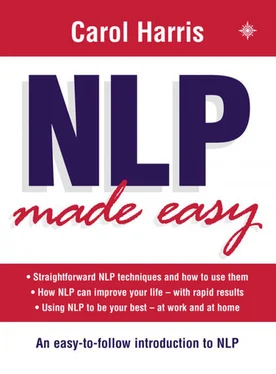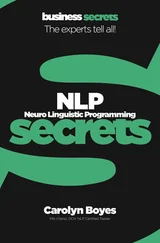To achieve the transition from present state to desired state, there are three elements which NLP considers: you (your own situation and disposition); others (those with whom you are dealing) and flexibility (the possibility of varying what you do in order to be effective).
We will be covering the history of NLP in the next chapter; the following is just a very brief outline to put the rest of this chapter into context.
NLP in its present form originated in the early 1970s in the USA, although much of it was based on concepts and approaches that were considerably older. The contribution of the founders to NLP as a discrete field of study was twofold: first, the codification, enlargement and extension of previously existing concepts into a practically useful developmental tool; and second, the promotion of ‘modelling’ (see Chapter 3) to replicate excellence in performance.
NLP stands for Neuro-Linguistic Programming, a title given to it by two of its major founders, Richard Bandler and John Grinder, although the term ‘neuro-linguistic’ had been coined by Alfred Korzybski much earlier and appeared in print in his book Science and Sanity in 1933. Neuro relates to the mind and how it works; linguistic relates to the ways in which people express or communicate their experience of the world; programming relates to the fact that people behave according to personal ‘programmes’ which govern their ways of being in the world. So NLP encompasses the ways in which people think and act in their everyday lives.
California in the 1970s was a hotbed of ideas and activities. Richard Bandler and John Grinder (see Chapter 2) began exploring how really effective people achieved their results. They turned their attention to a number of individuals, each of whom excelled in their own field, the three best-known of whom were Milton Erickson, Virginia Satir and Fritz Perls (see Chapter 2) .
In studying these people who excelled in their professions, Bandler and Grinder were curious to explore what was ‘the difference that made the difference’ – in other words what, specifically, led these people to excel. They found that each of their subjects exhibited specific personal patterns of behaviour and thinking, and it is these patterns, with their component elements, which form much of the basis for NLP.
So what are the elements involved in people’s patterns? Although not originally put into a specific unified model, certain discrete elements are involved; in particular thoughts, feelings and behaviour – in other words, how people think , how they feel and what they do . These three elements are the foundation of performance. Other elements can be added, in particular objectives, beliefs/values/attitudes and spirituality . (In taking these elements as key, I have drawn upon the work of David Gordon, Graham Dawes and Robert Dilts, and the next part of this chapter is based especially on the Experiential Dynamics model of Gordon and Dawes; see Chapter 3.)
What Bandler, Grinder and their colleagues noticed was that the people they studied had ways (or patterns) of thinking, feeling and behaving which made them effective. The people were not always aware of these patterns, but they could be noticed by keen outside observers. The conclusions reached were that once you can observe and describe such patterns, they can be copied by others. This meant that other people could learn to follow the same patterns in order to achieve similar results.
Now there is nothing startlingly new in this process; it is how much learning takes place. For example, to learn how to tie a shoelace a child has to copy (model) how someone else does it. What makes NLP particularly effective is its ability to break performance down into very small elements and to take account of ‘internal’ processes such as thoughts and feelings, as well as ‘external’ behaviour, when helping others to learn and develop.
Utilizing and Working with the Patterns
If we take each element of a pattern in turn – objectives, behaviour, thoughts, feelings and beliefs – we can see how NLP enables people to explore and enhance their performance. Later I will be returning to some of these aspects and showing how you can use them personally in your own development.
There are already well-established approaches to objective setting, for example the SMART approach (see Chapter 6) . NLP goes beyond these, and helps define objectives in a way which makes it much more likely that they will be achieved. To do this, NLP uses what it calls Well Formed Outcomes, or WFOs. The WFO model for setting effective objectives is covered in detail in Chapter 6and is the foundation for effective NLP work; by ensuring that objectives are well defined, progress and change are facilitated.
Behaviour is the only thing which is observable by others; they cannot see into your mind or know how you are feeling unless you either tell them or show them – and both of these processes (telling and showing) are behaviour. So NLP works with all aspects of behaviour, helping people to observe and respond to behaviour in useful and appropriate ways.
Some specific ways in which NLP works with behaviour are the following:
Helping people to learn skills
This often involves ‘role modelling’ someone with excellent skills in a particular field and learning how to transfer these skills to another person. Examples of this could include playing a musical instrument (finding out which techniques are used by professional musicians and emulating them) or taking part in sports (selecting top performers in different sporting fields – for example golf, athletics, tennis – and breaking down their performance into component parts in order to replicate it).
Creating and maintaining rapport and influence
NLP has specific ways of enhancing rapport and influence, notably the concept of ‘matching’ (or copying) other people in order to make them feel at ease. The idea is that most people feel comfortable with others who are similar to themselves, so by making yourself a little more like another person you can enhance their feelings of comfort and acceptance (see also Chapter 5) .
Using language to communicate and influence
There are a number of aspects here, including the following:
recognizing people’s personality and motivational patterns through their language patterns
recognizing which senses people favour or rely on, through listening to the actual words they use
 being able to use either precise or imprecise language where appropriate to achieve particular results
being able to use either precise or imprecise language where appropriate to achieve particular results
 using indirect language for persuasiveness and influence
using indirect language for persuasiveness and influence
respecting the actual words and phrases used by individuals, as those words represent their experience of reality
Language will be covered in more detail in Chapters 4– 6.
The elements of thought involve seeing (visualizing), hearing (imagining sounds or having ‘internal conversations’ or dialogue in one’s head), experiencing sensations (emotional or tactile), sensing smells or sensing tastes. In each of these areas, NLP enables people to notice their thoughts and then, if needed, to modify them and thereby their experience.
Читать дальше

 being able to use either precise or imprecise language where appropriate to achieve particular results
being able to use either precise or imprecise language where appropriate to achieve particular results










